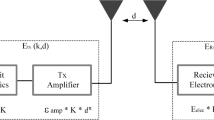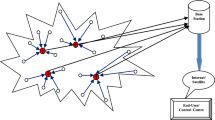Abstract
In WSN, mobility of the sink node is worthwhile since it creates potential way to gather information from sensor nodes through direct communication. To mitigate the delay experienced during the visiting period of entire network cluster head nodes, a mobile sink only gather information from limited special nodes called as rendezvous points and rest of cluster head nodes transmit their information to the nearby RP. It is extremely problematic to discover an optimal group of rendezvous points and decide the trajectory of mobile sink. In this paper, propose an intelligent approach for energy efficient trajectory design called Neuro fuzzy Emperor Penguin Optimization (NF-EPO) approach for mobile sink based IoT supported WSNs. This paper presented an adaptive Neuro fuzzy inference system (ANFIS) for optimal cluster head selection. Here, we considered the three input parameters of residual energy, neighbour node sharing and node behaviour history to choose the best CH. Finally, the effective routing algorithm of emperor penguin optimization (EPO) is used to find the rendezvous points and travelling path for mobile sink. The simulation outcomes illustrate that proposed method provides superior performance compared to other existing routing schemes. The efficiency of the system is determined using different metrics network lifetime, energy consumption with static and dynamic sink, end to end delay, bit error rate, packet loss ratio, buffer occupancy, channel load, jitter, latency, packet delivery ratio, and throughput.














Similar content being viewed by others
References
Wang J, Cao J, Ji S, Park JH (2017) Energy-efficient cluster-based dynamic routes adjustment approach for wireless sensor networks with mobile sinks. J Supercomput 73(7):3277–3290
Sharma S, Puthal D, Jena SK, Zomaya AY, Ranjan R (2017) Rendezvous based routing protocol for wireless sensor networks with mobile sink. J Supercomput 73(3):1168–1188
Sridhar KP, Baskar S, Shakeel PM, Dhulipala VS (2018) Developing brain abnormality recognize system using multi-objective pattern producing neural network. J Ambient Intell Humaniz Comput 10:1–9. https://doi.org/10.1007/s12652-018-1058-y
Mitra R, Sharma S (2018) Proactive data routing using controlled mobility of a mobile sink in wireless sensor networks. Comput Electr Eng 70:21–36
Aranzazu-Suescun C, Cardei M (2017) "Reactive routing protocol for event reporting in Mobile-sink wireless sensor networks". In Proceedings of the 13th ACM symposium on QoS and security for wireless and Mobile networks, ACM, pp. 43–50
Yim Y, Kim KH, Aldwairi M, Kim K-I (2017) Energy-efficient region shift scheme to support mobile sink group in wireless sensor networks. Sensors 18(1):90
Khan AW, Abdullah AH, Razzaque MA, Bangash JI (2015) VGDRA: a virtual grid-based dynamic routes adjustment scheme for mobile sink-based wireless sensor networks. IEEE Sensors J 15(1):526–534
Tunca C, Isik S, Donmez MY, Ersoy C (2015) Ring routing: an energy-efficient routing protocol for wireless sensor networks with a mobile sink. IEEE Trans Mob Comput 14(9):1947–1960
Zhao H, Guo S, Wang X, Wang F (2015) Energy-efficient topology control algorithm for maximizing network lifetime in wireless sensor networks with mobile sink. Appl Soft Comput 34:539–550
Hu Y-F, Ding Y-S, Ren L-H, Hao K-R, Han H (2015) An endocrine cooperative particle swarm optimization algorithm for routing recovery problem of wireless sensor networks with multiple mobile sinks. Inf Sci 300:100–113
Krishnan AM, Ganesh Kumar P (2016) An effective clustering approach with data aggregation using multiple mobile sinks for heterogeneous WSN. Wirel Pers Commun 90(2):423–434
Xie G, Pan F (2016) Cluster-based routing for the mobile sink in wireless sensor networks with obstacles. IEEE Access 4:2019–2028
Chang J-Y, Shen T-H (2016) An efficient tree-based power saving scheme for wireless sensor networks with mobile sink. IEEE Sensors J 16(20):7545–7557
Zhou ZB, Du C, Shu L, Hancke G, Niu J, Ning H (2016) An energy-balanced heuristic for mobile sink scheduling in hybrid WSNs. IEEE Trans Ind Inf 12(1):28–40
Shakeel PM, Baskar S, Dhulipala VS, Mishra S, Jaber MM (2018 Oct 1) Maintaining security and privacy in health care system using learning based deep-Q-networks. J Med Syst 42(10):186. https://doi.org/10.1007/s10916-018-1045-z
Tashtarian F, Moghaddam MHY, Sohraby K, Effati S (2015) On maximizing the lifetime of wireless sensor networks in event-driven applications with mobile sinks. IEEE Trans Veh Technol 64(7):3177–3189
Shakeel PM, Baskar S, Dhulipala VS, Jaber MM (2018) Cloud based framework for diagnosis of diabetes mellitus using K-means clustering. Health Inf Sci Syst 6(1):16. https://doi.org/10.1007/s13755-018-0054-0
Wichmann A, Korkmaz T (2015) Smooth path construction and adjustment for multiple mobile sinks in wireless sensor networks. Comput Commun 72:93–106
Kushal BY, Chitra M (2016) "Cluster based routing protocol to prolong network lifetime through mobile sink in WSN". In Recent Trends in Electronics, Information & Communication Technology (RTEICT), IEEE International Conference on, pp. 1287–1291
Wang J, Zhang Y, Cheng Z, Zhu X (2016) EMIP: energy-efficient itinerary planning for multiple mobile agents in wireless sensor network. Telecommun Syst 62(1):93–100
Tabibi S, Ghaffari A (2018) Energy-efficient routing mechanism for Mobile sink in wireless sensor networks using particle swarm optimization algorithm. Wirel Pers Commun:1–18
Kumar P, Amgoth T, Annavarapu CSR (2018) ACO-based mobile sink path determination for wireless sensor networks under non-uniform data constraints. Appl Soft Comput 69:528–540
Gharaei N, Hashim SZM, Pourasl AH (2018) Inter-and intra-cluster movement of Mobile sink algorithms for cluster-based networks to enhance the network lifetime. Ad Hoc Netw 85:60–70
Dahiya S, Singh PK (2018) Optimized mobile sink based grid coverage-aware sensor deployment and link quality based routing in wireless sensor networks. AEU Int J Electron Commun 89:191–196
Agrawal A, Singh V, Jain S, Gupta RK (2018) GCRP: grid-cycle routing protocol for wireless sensor network with mobile sink. AEU Int J Electron Commun 94:1–11
Preeth SKSL, Dhanalakshmi R, Kumar R, Shakeel PM (2018) An adaptive fuzzy rule based energy efficient clustering and immune-inspired routing protocol for WSN-assisted IoT system. J Ambient Intell Humaniz Comput:1–13. https://doi.org/10.1007/s12652-018-1154-z
MuhammedShafi P, Selvakumar S, Mohamed Shakeel P (2018) An efficient optimal fuzzy C means (OFCM) algorithm with particle swarm optimization (PSO) to analyze and predict crime data. J Adv Res Dyn Control Syst 10(06):699–707
Suh B, Berber S (2015) Rendezvous points and routing path-selection strategies for wireless sensor networks with mobile sink. Electron Lett 52(2):167–169
Author information
Authors and Affiliations
Corresponding author
Additional information
Publisher’s note
Springer Nature remains neutral with regard to jurisdictional claims in published maps and institutional affiliations.
Rights and permissions
About this article
Cite this article
Preeth, S.K.S.L., Dhanalakshmi, R. & Shakeel, P.M. An intelligent approach for energy efficient trajectory design for mobile sink based IoT supported wireless sensor networks. Peer-to-Peer Netw. Appl. 13, 2011–2022 (2020). https://doi.org/10.1007/s12083-019-00798-0
Received:
Accepted:
Published:
Issue Date:
DOI: https://doi.org/10.1007/s12083-019-00798-0




